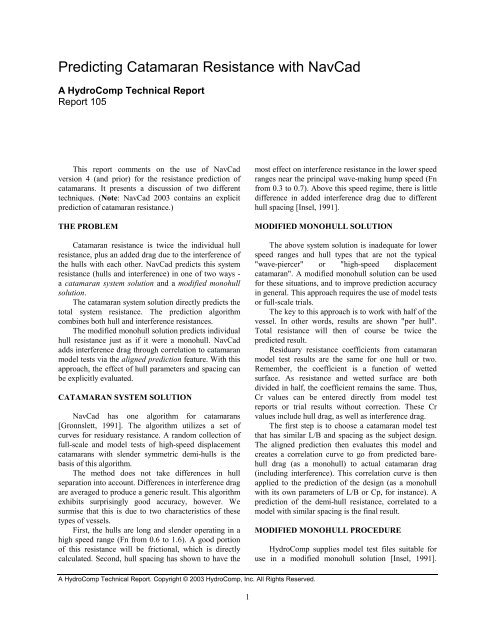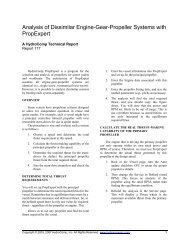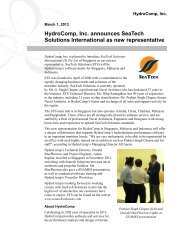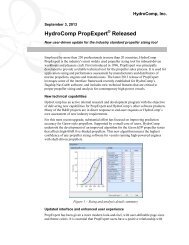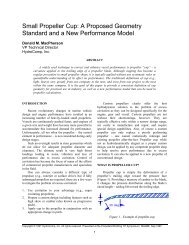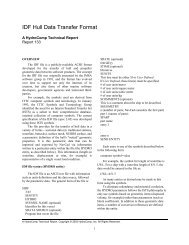105 - Hydrocomp Inc.
105 - Hydrocomp Inc.
105 - Hydrocomp Inc.
Create successful ePaper yourself
Turn your PDF publications into a flip-book with our unique Google optimized e-Paper software.
Predicting Catamaran Resistance with NavCadA HydroComp Technical ReportReport <strong>105</strong>This report comments on the use of NavCadversion 4 (and prior) for the resistance prediction ofcatamarans. It presents a discussion of two differenttechniques. (Note: NavCad 2003 contains an explicitprediction of catamaran resistance.)THE PROBLEMCatamaran resistance is twice the individual hullresistance, plus an added drag due to the interference ofthe hulls with each other. NavCad predicts this systemresistance (hulls and interference) in one of two ways -a catamaran system solution and a modified monohullsolution.The catamaran system solution directly predicts thetotal system resistance. The prediction algorithmcombines both hull and interference resistances.The modified monohull solution predicts individualhull resistance just as if it were a monohull. NavCadadds interference drag through correlation to catamaranmodel tests via the aligned prediction feature. With thisapproach, the effect of hull parameters and spacing canbe explicitly evaluated.CATAMARAN SYSTEM SOLUTIONNavCad has one algorithm for catamarans[Gronnslett, 1991]. The algorithm utilizes a set ofcurves for residuary resistance. A random collection offull-scale and model tests of high-speed displacementcatamarans with slender symmetric demi-hulls is thebasis of this algorithm.The method does not take differences in hullseparation into account. Differences in interference dragare averaged to produce a generic result. This algorithmexhibits surprisingly good accuracy, however. Wesurmise that this is due to two characteristics of thesetypes of vessels.First, the hulls are long and slender operating in ahigh speed range (Fn from 0.6 to 1.6). A good portionof this resistance will be frictional, which is directlycalculated. Second, hull spacing has shown to have themost effect on interference resistance in the lower speedranges near the principal wave-making hump speed (Fnfrom 0.3 to 0.7). Above this speed regime, there is littledifference in added interference drag due to differenthull spacing [Insel, 1991].MODIFIED MONOHULL SOLUTIONThe above system solution is inadequate for lowerspeed ranges and hull types that are not the typical"wave-piercer" or "high-speed displacementcatamaran". A modified monohull solution can be usedfor these situations, and to improve prediction accuracyin general. This approach requires the use of model testsor full-scale trials.The key to this approach is to work with half of thevessel. In other words, results are shown "per hull".Total resistance will then of course be twice thepredicted result.Residuary resistance coefficients from catamaranmodel test results are the same for one hull or two.Remember, the coefficient is a function of wettedsurface. As resistance and wetted surface are bothdivided in half, the coefficient remains the same. Thus,Cr values can be entered directly from model testreports or trial results without correction. These Crvalues include hull drag, as well as interference drag.The first step is to choose a catamaran model testthat has similar L/B and spacing as the subject design.The aligned prediction then evaluates this model andcreates a correlation curve to go from predicted barehulldrag (as a monohull) to actual catamaran drag(including interference). This correlation curve is thenapplied to the prediction of the design (as a monohullwith its own parameters of L/B or Cp, for instance). Aprediction of the demi-hull resistance, correlated to amodel with similar spacing is the final result.MODIFIED MONOHULL PROCEDUREHydroComp supplies model test files suitable foruse in a modified monohull solution [Insel, 1991].A HydroComp Technical Report. Copyright © 2003 HydroComp, <strong>Inc</strong>. All Rights Reserved.1
These test are based on a transom stern, round bilge hullform. Successful use of aligned prediction calls for abroad range of L/B and spacings (S/L ratio). This seriesof fifteen tests includes pure monohulls (for reference)and catamarans of L/B from 7 to 11, and S/L from 0.2to 0.5. Other tests can be entered and archived inNavCad's model/parent file system.A systematic procedure is described below.1. Review and select a catamaran model testreport that has similar L/B and S/L ratios.2. Enter this data into a NavCad model/parentfile. Speeds and Cr values can be entereddirectly from the report. If a slow speed formfactor was determined, this too can be enteredas shown. Hull data, however, should be forone hull. Especially remember to use thewetted surface and displacement for only onehull (half of the ship).3. Enter data for the hull design into NavCad forone hull, just as was done for the model.4. Build a resistance prediction. First, choose aprediction method that is suitable for the rangeof hull parameters.5. Choose aligned prediction and a resistanceparameter for alignment (Rbare, Rr or Rw, ifavailable).6. Define the model file name and run thecalculation.MODIFIED MONOHULL EXTRAPOLATIONA slightly different approach uses the extrapolationfeature of NavCad in place of the aligned prediction.Extrapolation simply uses a non-dimensionalresistance/displacement ratio correlation between modeland design to predict resistance. If a model and thedesign are quite close in shape and parameters, thenextrapolation can be a successful approach.Extrapolation creates a curve of resistance todisplacement ratio versus Froude number. It has theeffect of scaling a model's resistance in suitableproportion to size and speed. Total bare hull resistancecan be extrapolated, as can residuary (or even wavemaking)if the frictional or viscous portions arecalculated from an accurate wetted surface.HydroComp, <strong>Inc</strong>.13 Jenkins Court, Suite 200Durham, NH 03824 USATel (603)868-3344Fax (603)868-3366info@hydrocompinc.comwww.hydrocompinc.com2


